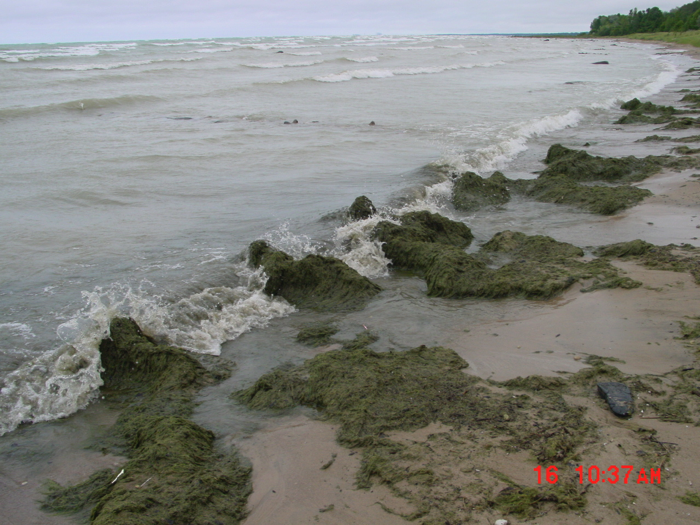
Cladophora algae washing up onto the Lake Huron shorelines has been a nuisance to Canadian beach-goers for more than a decade. Image: Todd Howell
Lined along Lake Huron’s Canadian coast stand beach cottages and homes filled with residents and vacationers who enjoy the scenic views, splashing in the water and relaxing on the beach.
But also occupying the beach are unpleasant, green globs of algae – something that’s caused problems on this shoreline for over the past decade.
“This was, and still is, a really curious situation,” said David Barton, a retired University of Waterloo biology professor and head researcher studying the increase of algae in this area since 2007.
Barton’s research was conducted along Lake Huron’s southeastern shoreline, from Sarnia northeast to Sauble Beach in Ontario.
Alongside Barton, Todd Howell, a Great Lakes ecologist from the Ontario Ministry of the Environment, and Cherie-Lee Fietsch, an environmental scientist at Bruce Power, studied the beach fouling, discovering multiple coinciding factors related to its increase.
When the water hits the lake and mixes along the shoreline, you can see effects on water quality, said Howell. He has been researching water quality in Lake Huron related to algae growth since 2003.
The researchers also found invasive species that feed on algae-eating benthic invertebrates – organisms living near the lakebed – contribute to the problem.
Because of the decrease in algae-feeding invertebrates that are preyed upon, more algae grows and eventually washes onto beaches.
Invasive species like the zebra mussels have caused other problems. According to their research, zebra mussels filter the water of organic matter and also redirect nutrients to the lake bottom where algae blooms flourish.
These two factors result in both the ability of light to more easily reach the algae on the lakebed and a surplus of nutrients to reach the plants and increase their growth rates.
Cottage Conundrum
Barton says there have been cottages around the southeastern coast of Lake Huron since the 1900s. However, they were much simpler when first built and used much less water than updated cottages today.

Over the decades, many new owners purchased the original properties, demolishing and building new homes, or renovating them into year-round houses.
The researchers say they believe that increased water use by the cottages may have boosted amounts of phosphorous left in shallow groundwater. During runoff events, the phosphorous is carried to the lake by tributary streams, and to larger rivers leading to Lake Huron.
However, the nutrients impacting the water and algae seem to affect mostly the immediate shoreline. That is true along this section of shoreline more than any other part of the lake, said the researchers.
Howell said one striking observation was that the portion of the lake seemingly affected directly from interaction with the shoreline doesn’t extend more than two to three meters (6 to 9.8 feet) into the lake.
“It’s a narrow band. The vast majority of the nearshore water past three meters deep has extremely low nutrient levels, levels almost undistinguishable from the open lake,” he said.
The bigger question, according to Howell, is nutrient distribution in the water and how that may affect algal growth.
Howell says these “diametrically opposed questions” of difference in nutrient distribution are challenging to understand and he continues to study the situation.
Municipal Action
Many townships along the lake have been dealing with residents’ complaints about the rapid

increase in shoreline algae since 2003.
Huron-Kinloss Township, which includes 15 miles of shoreline, has been dealing with such complaints first-hand.
“It’s the nuisance, it’s the smell, and sometimes it’s even difficult getting into the lake,” said Mike Fair, the township’s director of facilities and recreation.
Fair estimates Huron-Kinloss spends around $40,000 a year on algae cleanup after hiring a private contractor. The township has an extensive water testing plan to track what is in the water.
Aside from the local municipality involvement, Fair emphasized the importance of local environmental groups helping with problems affecting algal growth along the shoreline.
One organization, the Pine River Watershed Initiative based in Huron-Kinloss, protects the watershed of the Pine River, monitoring points where rivers and tributaries enter Lake Huron.
The organization started as an arm of Huron-Kinloss Township, but is now an independent effort to improve the lakeshore.
The group is building berms equipped with control outflow valves into agricultural fields to collect water during floods that may otherwise release nutrients into the watershed, Fair said.
